 Leading Blog | Posts by Month |
 Leading Blog | Posts by Month |
05.31.22

LeadershipNow 140: May 2022 Compilation
See more on
Posted by Michael McKinney at 07:09 AM
05.30.22

Patton's Principles of Leadership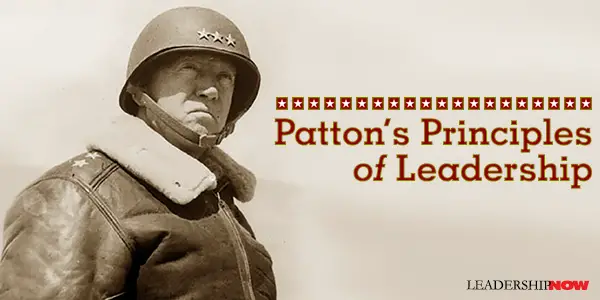
BORN in San Gabriel, California, in 1885, George S. Patton, Jr. was the general deemed most dangerous by the German High Command in World War II. Known for his bombastic style, it was mostly done to show confidence in himself and his troops, says author Owen Connelly. On December 21, 1945, Patton died in Heidelberg, Germany. The following day the New York Times wrote the following editorial: History has reached out and embraced General George Patton. His place is secure. He will be ranked in the forefront of America’s great military leaders.
Adapted from On War and Leadership: The Words of Combat Commanders from Frederick the Great to Norman Schwarzkopf by Owen Connelly
Posted by Michael McKinney at 07:26 AM
05.27.22

We Are Designed to Connect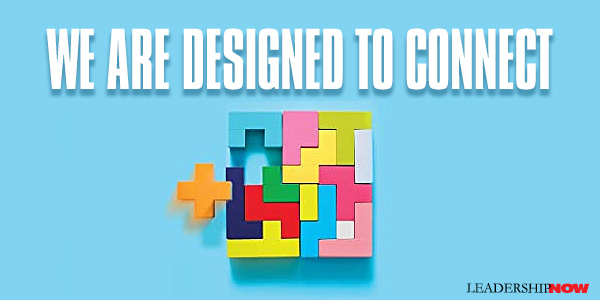
DO YOU feel like you belong at work? Seventy-two percent of workers feel lonely at least monthly. It is estimated that loneliness shaves 15 years off of a person’s life. Ouch. We are designed to connect with each other. And when we don’t, we react in much the same way as physical pain. The brain processes physical pain and loneliness in similar ways. Our lives become significant when we connect. In Connectable: How Leaders Can Move Teams from Isolated to All In, authors Ryan Jenkins and Steven Van Cohen write that “Connection is the default state of humans. We not only feel good together, but we feel normal.” Loneliness should not be shameful to admit. “It’s a signal. A signal that we need each other.” The bandit of belonging isn’t difference but distance. When someone else’s point of view, perspective, or behavior is unknown, unfamiliar, or unexplored, distance is created. Understanding and empathy grow with proximity. Abraham Lincoln once wisely said, ‘I don’t like that man. I must get to know him better.’ Distance is the bandit of belonging. They provide the LINK Framework to create belonging at work. Each letter in the LINK Framework represents a sequential step.
1. Look at Loneliness and identify loneliness in self and others. The well-being of your team members are your business. While you can’t control what they do outside of work, you can control “how seen, safe, and engaged they are at work. How you made them feel while they were at work has the potential to impact their off-work behaviors and ripple across the entire community.” A Less Lonely self-assessment is available online that includes specific recommendations to improve your loneliness level. 2. Invest in Connection and improve the strength of work relationships. This takes time, but they have offered actionable strategies to get you started. “Leaders should serve as ‘normalizers-in-chief’ when it comes to mental health challenges like loneliness. Workers want a more open and accepting culture, and leaders must be the ‘first responders’ to sound the alarm and address the issue. 3. Narrow the Focus and illuminate what’s most important at work. “Loneliness is lessened when a team narrows their focus on purpose, a clear direction, and growth.” As in the example given in the book, astronauts utilize these three elements to thrive in isolation. 4. Kindle the Momentum and inflame what’s working to sustain progress. The first three steps will help create a small fire that will begin to draw people together. “Inflame what’s working to sustain progress.” Go back over the first three steps. The framework works because prosocial actions like sharing, helping, and cooperating are contagious. Small, intentional, and routine behaviors will lessen loneliness. It has been said that all relationships have one law: Never make anyone feel alone, especially when you’re with them. And that’s easy to do in our distracted, social-tech world. We must take steps to avoid it. Pay attention to others. We all need distraction-free times, and we should communicate those times to our team. But we should also encourage those times when we are open to interruptions (and even use them to our advantage). “Interruptions are a free ticket to a renewed perspective, an uncovered blind spot, and possibly a better future.” Our commitment to lessen loneliness can take as little as 0.6, 1, and 5. “0.6 minutes (or 40 seconds) is how long it takes for loneliness to lesson during a two-person interaction. 1 person is the number of work friends it takes to feel less lonely. 5 minutes is the amount of time it takes in a team meeting to share something personal.” 
Posted by Michael McKinney at 07:52 AM
05.26.22

Leading Thoughts for May 26, 2022
IDEAS shared have the power to expand perspectives, change thinking, and move lives. Here are two ideas for the curious mind to engage with: Former president, CEO, and chairman of Procter & Gamble, John Pepper on values: “Over the years, I’ve seen that the strongest leaders are those who have enough confidence to seek input from others without losing the direction provided by their own internal compass. They understand that the objective of learning is not comfortable consensus. It is to make wiser, more informed choices.” Source: What Really Matters: Service, Leadership, People, and Values Ronald Heifetz and Marty Linsk on having compassion when leading change: “The people who fight the hardest also have the most to lose; and therefore, they deserve the most time, attention, care, and skill.” Source: Leadership on the Line: Staying Alive through the Dangers of Leading Look for these ideas every Thursday on the Leading Blog. Find more ideas on the LeadingThoughts index.
Posted by Michael McKinney at 07:32 AM
05.24.22

Amplify Your Influence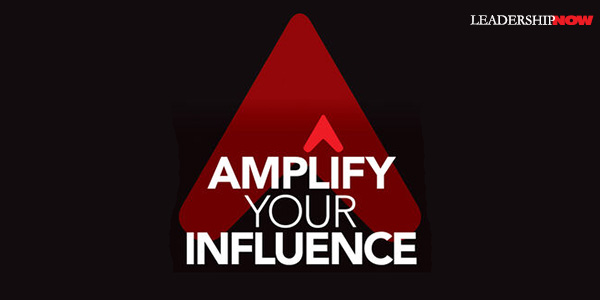
LEADERSHIP is intentional influence. Influence is a science that can be learned. Understanding how the brain functions is key to developing greater influence. René Rodriguez, the author of Amplify Your Influence, says influence is “about understanding how our brains, and those of our audience, process information.” The brain uses the reticular activating system (RAS) to sift through all of the messages we are bombarded with at any given time. From our vantage point, it filters out what is important and what we can ignore. As communicators, we have to learn how to appeal to our audience’s RAS to gain their attention. Working with the brain, our ideas can gain faster acceptance and is the idea behind the Amplifii Method. Frame > Message > Tie-Down The Amplifii method is a three-step sequence. Rodriguez tells us that sequence is everything. “Sequence is positioning your message and delivery of a message, story, or presentation in a way that aligns with the biological and neurological makeup of how our brains are wired to receive it.” Frame If you don’t provide the frame for your message, the audience will provide their own frame based on their past experiences, which may run counter to your intended message. If we don’t frame the message, we will lose it. “Story is a powerful device to control the narrative. But there are many other framing devices, too, including props, quotes, jokes, statistics, and even music.” The frame is designed to draw in your audience, create credibility, and build trust. But it does not build influence. “The frame sets the context for you to deliver your value proposition or core message. If delivered effectively, the message sets the stage for influence.” Message The goal of the message is to be clear and eliminate the need for assumptions of the part of your audience. It is essential to have a unique perspective. “To have influence, we must not only get others to see things from our perspective but fully understand their perspective as well.” When using clichés—and they can be powerful and sum up a lot of meaning—always qualify them. Acknowledge it is a cliché, and then explain exactly what it means to you and your audience. With the frame and your message, your audience doesn’t know where you’re going until the tie-down. That way they don’t jump ahead and fill in their own frames and conclusions, and so they remain open to your message and tie-down. Tie-Down The tie-down gives meaning. The frame and message without a tie-down are “like a joke without a punchline. It’s unfinished and doesn’t add value.” The tie-down explicitly outlines the precise value of the message in the context of what is important to the audience and their current needs. When you can accomplish all that, the magical outcome is influence. Naturally, self-awareness plays in your ability to influence anyone or anything. “Anyone can learn the skill of influence, but if we lose sight of how our behaviors affect those around us, those skills are for nothing. No skill or technique will make up for a lack of judgment or being tone-deaf.” A Very Simple Example Of all the examples Rodriguez gives, this example quickly gives you a taste of the Amplifii process. In a job interview, Janice is asked, “Tell us something you’re proud of in your life.” She responds, “I earned straight A’s my senior year in high school.” The answer is straightforward and direct. And gets the job done. But it leaves the listeners open to process it any way they want through their own biases and experiences. They can think she finally worked hard her senior year, or maybe she was privileged and had everything handed to her. Without providing a frame, what she was trying to convey could easily be lost. A better answer using the Amplifii process looks like this: FRAME: “Unfortunately, growing up, I was surrounded by adults who told me I wasn’t very smart. When adults tell you that as a child, you begin to believe it, and I hard a hard time in school. But something happened in my senior year in high school. I looked at myself in the mirror and said, ‘I’m either going to believe them forever or I’m going to do something about it and prove them wrong.’ I decided I was going to do something about it. And I did. 
Posted by Michael McKinney at 02:29 PM
05.20.22

Values Are Guardrails
SUSTAINABLE LEADERSHIP is based on positive values that form our character. Values are like guardrails. When we are driving, we find guardrails in areas of danger or uncertainty. They are placed there to keep us on the road and not into the ditch or off the cliff. Values are like that. Values protect us from life’s pressures and temptations. In this way, we can avoid ethical and moral lapses in the heat of the moment. Negative outside influences are all around us. They can force us to react rather than respond and derail our leadership by compromising our judgment and common sense. Values are the principles and beliefs by which we live our lives and make decisions. Values are about doing the right thing—a predetermined action—when we have a choice to make. Values can be difficult because they draw a line in the sand—a guardrail. But that guardrail strengthens you and helps you to make calm, rational decisions in otherwise emotional situations. Values form your character. Your character becomes the culture of the organization—the organizational operating system. Values lived build trust. 10 Things to Remember About Values
Posted by Michael McKinney at 10:08 AM
05.19.22

Leading Thoughts for May 19, 2022
IDEAS shared have the power to expand perspectives, change thinking, and move lives. Here are two ideas for the curious mind to engage with: London Business School professors Rob Goffee and Gareth Jones on conforming yet remaining authentic: “Leaders must conform enough if they are to make the connections necessary to deliver change. Leaders who succeed in changing organizations challenge the norms—but rarely all of them, all at once. They do not seek out instant head-on confrontation without understanding the organizational context. To change an organization, the leader must first gain at least minimal acceptance as a member.” Source: Why Should Anyone Be Led by You? What It Takes to Be an Authentic Leader Harvard Professor Joseph Badaracco on quiet leadership: “The most effective leaders are rarely public heroes. These men and women aren’t high-profile champions of causes, and don’t want to be. They don’t spearhead ethical crusades. They move patiently, carefully, and incrementally. They do what is right—for their organizations, for the people around them, and for themselves—inconspicuously and without casualties.” Source: Leading Quietly: An Unorthodox Guide to Doing the Right Thing Look for these ideas every Thursday on the Leading Blog. Find more ideas on the LeadingThoughts index.
Posted by Michael McKinney at 06:17 AM
05.16.22

7 Concrete Actions That Can Help You Be a Champion of Workplace Inclusion
ENGAGING leaders within your organization may require leveraging several different kinds of elements, depending on what your company’s culture most heavily emphasizes. Data and research in the business case may be enough to convince some leaders that they need to engage in diversity, equity, inclusion, and belonging (DEIB). For others, it may be how you build a relationship and emotional connection to DEIB through storytelling and trust. For still others, it can depend on how strongly you can integrate DEIB actions into leaders’ business priorities and make this work as low lift as realistically possible. It’s up to you to find out what’s most important to your leaders and connect DEIB into that. Most of the time, I find that leaders have already bought into the concepts of DEIB. What they lack is a clear understanding of how to make progress. Taking no action at all is considered safer than taking the wrong actions that might cause controversy or inadvertently offend someone. What this means is they need a clear road map of actions to take. This can take the form of a customized DEIB action plan that includes a data dashboard supporting your recommended areas of focus. Or it can be a more generic set of suggestions that any leader across the organization can take, such as stating publicly on social media that they are committed to DEIB and looking for ways to get closer to different communities. What’s most important is to define a set of actions that are concrete enough to move the firm toward its defined DEIB goals. Simple advice such as “hire more people of color” is not that helpful because the organization would be doing that if they already knew how to do it well. It’s the fact that they don’t know what to do that we need to pay attention to. So I try to give leaders easy, concrete actions that they can do to be a champion of DEIB, such as these: • Audit your networks. If it is not diverse, start following and connecting with people from diverse backgrounds. For every new connection you make that is in the majority, invite another connection that is not. • Educate yourself. Either read articles or books, listen to podcasts, or attend webinars on DEIB. Actively participate in trainings offered by your employer. • Communicate your support. When you post a job, explicitly state that you encourage people from diverse backgrounds to apply. Talk to your teams about your commitment to and expectations of DEIB. • Amplify minority voices. Give credit to ideas shared by underrepresented groups in meetings. Share social media posts from underrepresented talent. • Make space. Invite people who haven’t spoken during a meeting to share their thoughts. Make sure event speakers are representative of diverse backgrounds. • Show up. Attend ERG events whether you have an affinity for that ERG or not. Listen and learn. • Seek input. If you’re leading an initiative that will impact an underrepresented group, make sure you involve their perspective in it as early as possible. This is not an exhaustive list by any means, but it contains a few basic ideas that I have found to be helpful guideposts for leaders who are seeking to demonstrate their DEIB commitment. Of course, it’s not enough for leaders to show their top-down commitment and role-model inclusive behaviors. It must also be coupled with employee support for DEIB initiatives to truly take hold.  
Posted by Michael McKinney at 08:03 AM
05.13.22

Disrupting the Game: Lessons from Nintendo’s Reggie Fils-Amié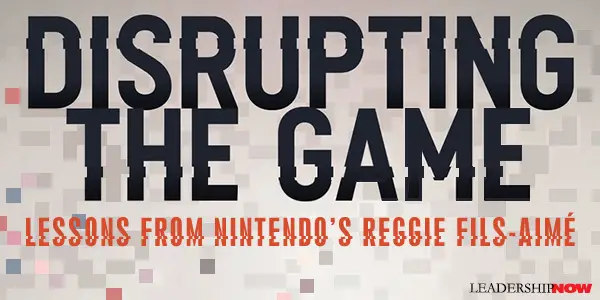
GROWING up the son of Haitian immigrants in the Bronx, Reggie Fils-Amié became the president of Nintendo of America through preparation and making the most of every opportunity. Curiosity drove him to new experiences. He writes in Disrupting the Game: Opportunity came when I saw the potential to achieve in ways that others didn’t immediately see. This led me to often choose untraditional paths that ran counter to expectations. Disrupting the Game is both a memoir and leadership guide. Placed throughout the journey he shares with us are what he calls “The So What.” These are the lessons gained from those experiences that he hopes will provide actionable advice in our own lives. Below are a several of the over forty lessons presented in the book: There’s a fine balance between staying true to your belief versus just being stubborn. Do you truly believe in a particular course of action, or is it your ego talking? When you are making a difficult or complex judgment, it’s especially difficult to know your own motivation. Be honest with yourself. Separate your own desire to be right or win an argument from your own core beliefs. Can you honestly say that you believe in your recommendation because it’s the right thing to do—that you’d get behind it even if someone else suggested it? 
Posted by Michael McKinney at 08:33 AM
05.12.22

Leading Thoughts for May 12, 2022
IDEAS shared have the power to expand perspectives, change thinking, and move lives. Here are two ideas for the curious mind to engage with: Anthropologist Grant McCracken on inspiring innovation and creativity: “People who escape familiar groups and make contact with unfamiliar ones become smarter and more creative. Former Boston Celtics coach Brad Stevens on servant leadership: “Do you want to be around somebody who lifts you up, or somebody that breaks you down? That’s why whenever people ask me what’s your leadership style, my answer is, ‘It should be you.’ There’s an authenticity that is needed for leadership. If it’s not real, then it’s not going to work. Source: Getting to Us: How Great Coaches Make Great Teams by Seth Davis Look for these ideas every Thursday on the Leading Blog. Find more ideas on the LeadingThoughts index.
Posted by Michael McKinney at 09:03 AM
05.09.22

The Crux: How Leaders Become Strategists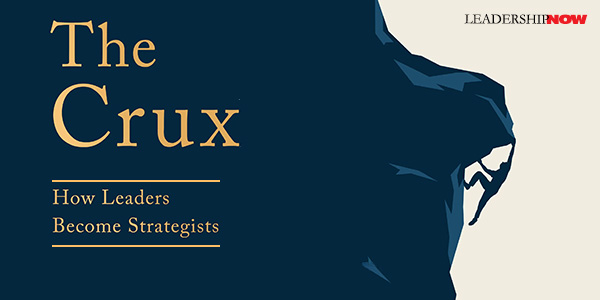
THE CRUX of the matter is a phrase that has been around for over 200 years. Richard Rumelt recalls climbers in France calling the boulders they climb “problems,” with the toughest part of the problem referred to as “the crux.” Climbers will often look for a challenge that has the greatest reward and whose crux they believe they can solve. In The Crux, Rumelt uses this as a metaphor for life. We all face problems, and finding the crux is the secret sauce where we “can gain the most by designing, discovering, or finding a way to move through and past it.” Rumelt uses the term crux to describe a three-part strategic skill: The first part is judgment about which issues are truly important and which are secondary. The second part is judgment about the difficulties of dealing with those issues. And the third part is the ability to focus, to avoid spreading resources too thinly, not trying to do everything at once. The combination of these three parts lead to a focus on the crux—the most important part of a set of challenges that is addressable, having a good chance of being solved by coherent action. We often get off to a bad start by not understanding what a strategy is. “There is a widespread misconception that a business strategy is some sort of long-range sketch of a desired destination. I encourage you to think of strategy as a journey through, over, and around a sequence of challenges.” To have a single unchanging strategy that spans through challenges “reduces the concept to a slogan or motto, like ‘Be the best.’ Strategy is problem-solving, and it is best expressed relative to a particular challenge.” Strategy is for problem-solving, but to do that, you need to get to the crux of the problem. “Don’t start with goals—start by understanding the challenge and finding its crux.” The concept of a crux narrows attention to a critical issue. A strategy is a mix of policy and action designed to overcome a significant challenge. The art of strategy is in defining a crux that can be mastered and in seeing or designing a way through it. Strategy is an exercise in power because it always involves a shift in power and resources. When faced with a number of challenges, we tend to deliver incoherent goals—actions that contradict each other. They may sound like nice goals designed to please but are incoherent and therefore unattainable. We get nowhere. (And this sums up our political gridlock.) One sees how coherence is easily lost. The cost of coherence is saying no to many interests with reasonable values and arguments. A strategist tries to not be a politician. The art of compromise and building the big tent that everyone can shelter under is not that of the strategist. Rather, it is coherence aimed at the crux of the problem. In other words, actions should not conflict with one another. For example: Don’t base your competitive edge on continuing development but then cut R&D to make your numbers. After Rumelt goes through a series of business problems that give birth to his concept of the crux as it relates to strategy, he then dispels some myths and explains how we get to the crux. Getting to the crux of the issue is harder than one might think. We are too often stuck in our assumptions. Often it requires a reframing, a new analogy, or a reanalysis of data in ways that we have not previously considered. Organizational issues “can be resolved successfully using the principles of crux-strategy problem-solving diagnosis, reduction to a crux, performance concepts, and coherent action.” You don’t want to start with goals. You want to start with challenges. “A collection of goals or metrics is not a strategy. A strategy is a reasoned argument about the forces at work in a situation and how to deal with them.” Further, “Strategy work defines the goals and objectives to be sought. Good strategy work begins with recognizing a challenge and in understanding the difficulties in overcoming it. Good strategy work produces policies, actions, and objectives.” About mission statements, Rumelt says, “If you accept that strategy is a form of problem-solving, that it is a journey, and that it is a response to challenges, then mission statements are not helpful in strategy work. They are a waste of time and effort.” Financial goals, mission statements, and quarterly earnings become distractions when strategy work. Rumelt walks us through a crux defining, strategy creating process, which he calls the Strategy Foundry. It is an intense challenge-based discussion to get to the crux that will form the basis of the strategy. It is not goal setting or budgeting. By starting with the challenge, the group becomes responsible for designing a response rather than choosing among plans already advanced by members or others, or just filling in the blanks for a longer-term budget. Each story in The Crux will make you rethink strategy—what it is and is not and how it is created. The principle of the crux is also a good life lesson. Finding the crux will help you determine the appropriate response to a given set of circumstances. 
Posted by Michael McKinney at 10:31 AM
05.06.22

Disagreeing Agreeably: Using Conversational Aikido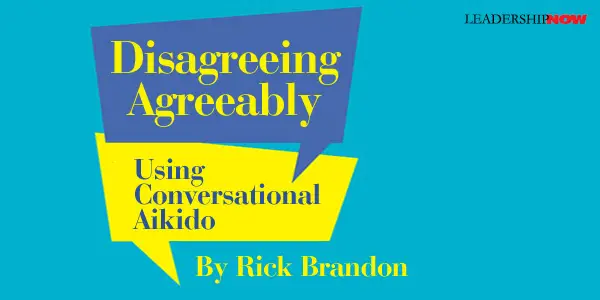
YOUR boss tells you to implement a new idea or policy that you believe will cause problems (because it’s a boneheaded idea!). You’d be out of integrity not to raise your concerns or tactfully disagree. Still, you don’t want to commit a career-limiting move. Or, you’re comfortable with the overall idea, but you want to foster deeper thinking about potential obstacles, and oh, yeah ... you want to live to talk about it! You’ll Disagree Agreeably by using the Conversational Aikido Technique with managers, associates, clients, vendors, friends, family (especially kids), and others in order to:
Aikido Philosophy. The Eastern martial art of aikido is about harmony, not conflict, and equates well to Disagreeing Agreeably. Western boxing involves overpowering a foe—force against force. Aikido isn’t about striking, overpowering, or forcing an opponent to comply. It entails moving with and aligning with the other’s energy to remain in control. Conversational Aikido involves understanding their viewpoint and finding its merit before expressing your differing point of view. Using Political Savvy. Conversational Aikido is interpersonally savvy and politically savvy. When power, politics, and ego are involved, this tool helps you to fly under the radar of a superior’s “hyperactive ego gland.” Your well-intentioned feedback may be interpreted by ego-trippers as unwarranted criticism or an implied threat. Politically naïve people put their foot in their mouth so much they contract Athlete’s Tongue. They could floss with shoelaces! The Conversational Aikido Technique prevents you from wounding the king or queen. The king or queen is still alive. Your head may get chopped off! Don’t let your intellectual “rightness” or subject matter expertise lure you into criticizing an idea in an overly zealous way, even if the egotist doesn’t possess positional power. Being in someone’s doghouse is unwise regardless of their status. The Conversational Aikido Technique: Step-by-Step Influence adeptness requires awareness of the impact of your behavior. You already know that direct but respectful wording and tone must supplant inflammatory (Aggressive) language or weak (Passive) language. Let’s plug Assertive Speaking, Active Listening, and the Straight Talk Mindset into the steps of the Conversational Aikido Technique for Disagreeing Agreeably:
1. Listen Non Judgmentally and Empathically to the Idea. Focus your body in order to pay empathic, nonjudgmental attention to the person’s idea or request, regardless of what you’re thinking. Paraphrase thoughts and feelings to capture the idea’s essence, rationale, and emotions behind it. This demonstrates respect for the person, proves that you’ve understood their idea, and conveys that you accept its validity for that person. You’re absorbing the idea instead of prematurely reacting, evaluating, or dismissing it. This is akin to aikido’s aligning philosophy, as is the next step. 2. Generously State the Merits of the Idea. Before expressing negative reactions, first show that you see the pluses of the idea or proposed action. Genuinely say everything you like about the idea, and not just in a token way. Really lean into this step with multiple, specific, and sincere, positive comments about the idea’s redeeming qualities and benefits. Like Mary Poppins sings in the movie, “A spoonful of sugar helps the medicine go down.” You’re helping the person consider their idea’s downsides by first being in harmony with its upsides (acknowledging). This “spoonful of sugar” does NOT mean you are BS-ing or sugar-coating your viewpoint about the idea’s cons or drawbacks. Most ideas have some merit, even if it’s just the passion that the person has for it or the energy they invested into developing it. If you can’t find anything positive to say, can you spell r-i-g-i-d? Aren’t you being a crap-detector? Show good faith by digging deeper to find some aspect of the person’s idea that you respect. It’ll pave the way for what comes next—your concerns or disagreement. Lead-in phrases for this merits step include: “What I like about your idea is ... I can appreciate ... You’ve done your homework ... What’s admirable is how you ... The upsides are clear, like ... I support your goal of ... Some merits I see are ... We’re really aligned on ...” 3. Tactfully Surface Your Concerns. You’ve earned the right to candidly share the idea’s variables they haven’t considered or missing pieces. You’ve generously shared the pros, so don’t be shy about voicing the cons. This step’s lead-in phrases include: “Let’s also consider the possibility that . . . An issue might be ... One concern is ... A major challenge could be ... I’m not as confident as you since ... How will we respond to ... A downside I see is ...” When bridging from acknowledging the idea’s positives to voicing reservations, steer clear of the word but or its cousins, however and nevertheless. They erase everything you said before them. The person will only hear the “but,” not the merits you’ve cited. You know what I mean if a romantic interest has ever said to you, “I really like you as a friend, but I’m not interested in dating you.” Ugh. “But” risks your “likes” about an idea coming across as merely going through the motions. 4. Give Your Conclusion. You’ve conveyed both sides of the coin—the idea’s pros (merits) and cons (concerns)—acknowledging that they can stand side by side in the universe. Now, give your bottom-line conclusion, which might be to problem-solve around your concerns and move forward, to withhold support until later, or to graciously decline supporting the idea. You still can convey respect for the person. You’re not rejecting them, just their idea.  
Posted by Michael McKinney at 07:09 AM
05.05.22

Leading Thoughts for May 5, 2022
IDEAS shared have the power to expand perspectives, change thinking, and move lives. Here are two ideas for the curious mind to engage with: Professor Scott Galloway on the worst advice given to young people: “Your job is to find something you’re good at. And then spend thousands of hours and apply the grit and the sacrifice and the willingness to break through hard things to become great at it. Because once you’re great at something, the economic accouterments of being great at something, the prestige, the relevance, the camaraderie, the self-worth of being great … will make you passionate about whatever it is. Here’s the problem with believing you should follow your passion: Work is hard. And when you run into obstacles and you face injustice, which is a common guaranteed attribute of the workplace, you’ll start thinking, ‘I’m not loving this. This is upsetting and hard. It must not be my passion.’ That is not the right litmus test.’” Source: The Pursuit of Excellence: The Uncommon Behaviors of the World’s Most Productive Achievers by Ryan Hawk Stephen M. R. Covey on command and control: “Command & Control is about getting things done, but it misses the potential power of the people who get those things done. Command & Control is about being efficient with people, trying to motivate them instead of inspiring them. It’s about self-interest and competing rather than serving and caring. And if all else fails, it’s about barking out the orders so everyone does exactly what they’re supposed to do—not because they want to, but because they have to. In short, it’s about controlling people instead of unleashing their potential.” Source: Trust and Inspire: How Truly Great Leaders Unleash Greatness in Others Look for these ideas every Thursday on the Leading Blog. Find more ideas on the LeadingThoughts index.
Posted by Michael McKinney at 07:27 AM
05.03.22

Make No Small Plans: Lessons on Thinking Big, Chasing Dreams, and Building Community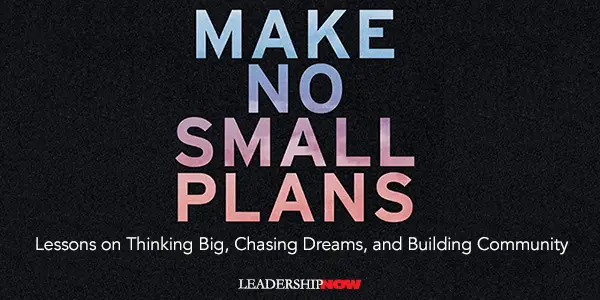
BIG IDEAS are often met with, “It’ll never work.” And if that doesn’t stop us, then our inner voice may make us throw in the towel. Make No Small Plans: Lessons on Thinking Big, Chasing Dreams, and Building Community is the incredible story of how four friends, who in the beginning, had no idea what they were doing—Elliott Bisnow, Brett Leve, Jeff Rosenthal, and Jeremy Schwartz—took Bisnow’s idea and turned it into a reality. Bisnow wanted to “bring together twenty creative people and build a peer group so that we can connect with each other, meet new friends, and brainstorm.” He contacted twenty of the best people he knew, and they all turned him down. The first impression I get from Make No Small Plans is that most of us don’t work as hard as we could. We give up too soon. At this point, many people would just quit or decide they needed a new idea. Bisnow didn’t quit. He upped the stakes. He decided he was thinking too small. And Summit Series was born. “Sometimes you can have the right idea and pitch it to the wrong person.” He went after big-name entrepreneurs and invited them to an all-expense-paid trip to Utah to discuss professional challenges they each faced and collaborate on solutions. To make a long story short, it was the beginning of a journey that would eventually become Summit—a community that inspires and connects entrepreneurs, academics, athletes, artists, astronauts, authors, chefs, engineers, explorers, philanthropists, spiritual leaders, and scientists—co-founded by Bisnow, Leve, Rosenthal, and Schwartz. In building their community, former CEO of Zappos Tony Hsieh gave them some valuable advice at one of their first events: “Are there people at this event who you wouldn’t invite to your parent’s home for dinner if not for their personal and professional success? Another thread that runs through their journey is to leave space for the unplanned. “It doesn’t matter how prepared you are, because the day will never unfold the way you planned it. What matters most is how you react to the unexpected moments.” Takeaways from the journey to build Summit:
Having had a taste of success, they are now looking for smart people doing incredible things—“change-the-world” stuff—and it can become easy to forget that they once only had a dream and a desire to do something special. People who are doing incredible things are already doing incredible things, and they can mentor those with only a passion. Remaining grounded in their history, they need to seek out and encourage the people who are now once like they once were, with only a passion and a dream to do incredible things and make it their mission to change their world. Another good lesson for all of us. 
Posted by Michael McKinney at 11:32 AM
05.01.22

First Look: Leadership Books for May 2022Here's a look at some of the best leadership books to be released in May 2022. Be sure to check out the other great titles being offered this month.
What passes for strategy in too many businesses, government agencies, and military operations is a toxic mix of wishful thinking and a jumble of incoherent policies. Richard P. Rumelt’s breakthrough concept is that leaders become effective strategists when they focus on challenges rather than goals, pinpointing the crux of their pivotal challenge—the aspect that is both surmountable and promises the greatest progress—and taking decisive, coherent action to overcome it. Rumelt defines the essence of the strategist’s skill with vivid storytelling, from how Elon Musk found the crux that propelled the success of SpaceX to how the American military came to grips with the weaknesses of its battle strategy. Musk’s core challenge, for example, was rocket reusability. His intense focus on the soft landing of SpaceX’s rockets enabled them to be used again—radically reducing the cost of putting a pound in orbit. Musk’s strategy was not based on how value is created or how to position SpaceX in its industry. It was a design foraction, the mental maneuver that focuses energy on what really made a difference through understanding the crux and creating an effective response that led to breakthrough.
“We are living an earned life when the choices, risks, and effort we make in each moment align with an overarching purpose in our lives, regardless of the eventual outcome.” That’s the definition of an earned life. But for many of us, that pesky final phrase is a stumbling block: “regardless of the eventual outcome.” Not being attached to the outcome goes against everything we’re taught about achievement and fulfillment in modern society. But now, in his most personal and powerful work to date, world-renowned leadership coach Marshall Goldsmith offers a dazzling but simple approach that accommodates both our persistent need for achievement and the inescapable “stuff happens” unfairness of life. Goldsmith implores readers to avoid the Great Western Disease of “I’ll be happy when. . . .” He offers practical advice and exercises aimed at helping us shed the obstacles, especially the failures of imagination, that prevent us from creating our own fulfilling lives. With this book as their guide, readers can close the gap between what they plan to achieve and what they actually get done—and avoid the trap of existential regret, the kind that reroutes destinies and persecutes our memories. Packed with illuminating stories from Goldsmith’s legendary career as a coach to some of the world’s highest-achieving leaders as well as reflections on his own experiences, The Earned Life is a road map for ambitious people seeking a higher purpose.
Unresolved workplace conflict wastes time, increases stress, and negatively affects business outcomes. But conflict isn’t the problem, mismanagement is. Leaders unintentionally mismanage conflict when they fall into patterns of what Marlene Chism calls “the Three As:” aggression, avoidance, and appeasing. “These coping mechanisms are ways human beings avoid the emotions that come with conflict, but in the end it’s all avoidance,” says Chism. In this book she shows how to fearlessly deal with conflict head-on by expanding your conflict capacity. Conflict capacity is a combination of three elements. The foundation is the Inner Game—the leader’s self-awareness, values, discernment, and emotional integrity. The Outer Game is the skills, tools, and communication techniques built on that foundation. Finally, there’s Culture—the visible and invisible structures around you that can encourage or discourage conflict.
Reggie Fils-Aimé, retired President and Chief Operating Officer of Nintendo of America Inc., shares leadership lessons and inspiring stories from his unlikely rise to the top. Although he’s best known as Nintendo's iconic President of the Americas-immortalized for opening Nintendo’s 2004 E3 presentation with, “My name is Reggie, I'm about kicking ass, I'm about taking names, and we're about making games”-Reggie Fils-Aimé’s story is the ultimate gameplan for anyone looking to beat the odds and achieve success. Learn from Reggie how to leverage disruptive thinking to pinpoint the life choices that will make you truly happy, conquer negative perceptions from those who underestimate or outright dismiss you, and master the grit, perseverance, and resilience it takes to dominate in the business world and to reach your professional dreams.
At the heart of Admiral James Stavridis’s training as a naval officer was the preparation to lead sailors in combat, to face the decisive moment in battle whenever it might arise. In To Risk it All, he offers up nine of the most useful and enthralling stories from the US Navy’s nearly 250-year history, and draws from them a set of insights that we can all put to use when confronted with fateful choices. Conflict. Crisis. Risk. These words have a distinct meaning in a military context that we hope will never apply identically in our own lives. But at the same time, as Admiral Stavridis shows with great clarity, many lessons are universal. To Risk it All is filled with thrilling and heroic exploits, but it is anything but a shallow exercise in myth burnishing. Every leader in this book has real flaws, as all humans do, and the stories of failure, or at least the decisions that have been defined as such, are as crucial as the stories of success. In the end, when this master class is concluded, we will be better armed for hard decisions both expected and not.
Most people try their best to avoid conflict. Bar Rescue host Jon Taffer understands that. Conflict can have negative results. It’s easy to think that the key to a happy workplace or marriage is to avoid conflict. In reality, that’s not the case—the key is to argue smarter. Enter the Toolkit for Getting Conflict Right. Taffer’s approach is focused on deliberate conflict—otherwise known as “conflict with a purpose.” There are selective and strategic ways to have difficult conversations, and when doing so, to stay aware of your objectives rather than escalating tension unnecessarily. As Taffer explains, “The key is to act affirmatively, constructively, and productively.” Eliminating conflict isn’t always the answer; inevitably there will be times when it will arise. Engaging in conflict can be a way to clear the air, and get to the bottom of issues that, once resolved, can strengthen friendships, ease tensions at work, and address problems before they have a chance to bubble over.
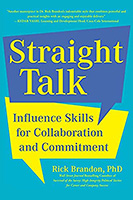 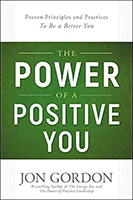 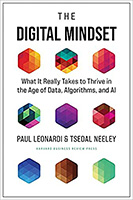
 Build your leadership library with these specials on over 28 titles. All titles are at least 40% off the list price and are available only in limited quantities. “To add a library to a house is to give that house a soul.” — Cicero
Posted by Michael McKinney at 07:15 AM
|
BUILD YOUR KNOWLEDGE


How to Do Your Start-Up Right STRAIGHT TALK FOR START-UPS 
Grow Your Leadership Skills NEW AND UPCOMING LEADERSHIP BOOKS 
Leadership Minute BITE-SIZE CONCEPTS YOU CAN CHEW ON 
Classic Leadership Books BOOKS TO READ BEFORE YOU LEAD |
|